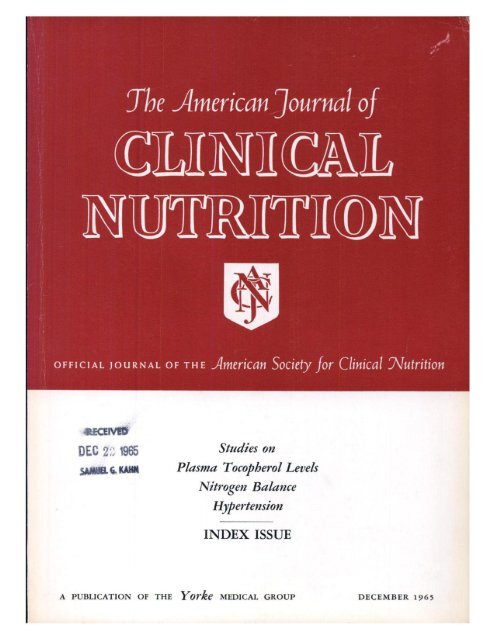Resistance training increases myofibrillar protein synthesis in middle-to-older aged adults consuming a typical diet with no influence of protein source: a randomized controlled trial
IF 6.5
1区 医学
Q1 NUTRITION & DIETETICS
引用次数: 0
Abstract
Background
The primary protein source of a diet may impact skeletal muscle maintenance with advancing age. The impact of the animal and plant protein contents of a typical protein-containing diet on muscle anabolism in middle-to-older aged adults is unknown.
Objectives
To determine muscle adaptive remodeling response to a 10-d dietary intervention containing divergent protein sources, with and without resistance exercise training (RET) in middle-to-older aged adults.
Methods
In a single-blind randomized controlled trial, 27 50- to 70-y-old participants consumed 1.0 g·kg BM−1·d−1 of protein from an animal-focused whey protein–supplemented diet (AW-D) or plant-focused pea protein–supplemented diet (PP-D). Throughout the 10-d diet intervention, unilateral knee extensor RET was performed every other day. Deuterated water ingestion and skeletal muscle biopsies enabled measurement of daily integrated myofibrillar protein synthesis (iMyoPS) rates in the trained and untrained legs. Changes in metabolic rate, body composition, lipid profiles, renal function, whole-body nitrogen balance (WBNB), strength, and muscle architecture were also determined.
Results
Daily iMyoPS rates were significantly greater (P < 0.001) in the trained leg compared with the untrained leg for AW-D (1.44 ± 0.26 vs. 1.29 ± 0.27 %⋅d−1) and PP-D (1.50 ± 0.17 vs. 1.34 ± 0.21 %⋅d−1) with no differences between groups, within leg. Training and diet did not affect intracellular anabolic signaling, muscle architecture, strength, metabolic rate, renal function, or WBNB. Serum non–HDL-cholesterol was significantly (P = 0.014) lower following the intervention for PP-D only (pre: 3.89 ± 0.84; post: 3.37 ± 0.78 mmol⋅L) with no other changes in lipid profiles.
Conclusions
The 10-d provision of 1.0g·kg BM−1·d−1 from predominantly plant-derived or animal-derived protein does not influence daily iMyoPS rates in middle-to-older aged adults and has little impact on metabolic and renal health parameters. RET enhances rates of daily iMyoPS in middle-to-older aged adults consuming a typical protein-containing diet, with no influence of protein source.
Clinical Trial Registry number
ClinicalTrials.gov NCT05574205 (https://clinicaltrials.gov/study/NCT05574205).
在一项随机对照试验中,抗阻训练增加了中老年人的肌原纤维蛋白合成。
背景:随着年龄的增长,饮食中的主要蛋白质来源可能会影响骨骼肌的维持。典型的含蛋白质饮食中动物和植物蛋白质含量对中老年人肌肉合成代谢的影响尚不清楚。目的:确定肌肉适应性重构对10天饮食干预的反应,包括不同的蛋白质来源,有和没有阻力运动训练(RET)的中老年人。方法:在一项单盲随机对照试验中,27名50-70岁的参与者从以动物为重点的乳清蛋白补充饲料(AW-D)或以植物为重点的豌豆蛋白补充饲料(PP-D)中摄入1.0g·kg BM-1·day-1蛋白质。在为期10天的饮食干预中,每隔一天进行一次单侧膝关节伸肌RET。氘化水摄入和骨骼肌活检可以测量训练和未训练腿部的每日综合肌纤维蛋白合成(iMyoPS)率。测定代谢率、体成分、脂质谱、肾功能、全身氮平衡(WBNB)、力量和肌肉结构的变化。结果:每日iMyoPS率(P-1)和PP-D率(1.50±0.17 vs 1.34±0.21%⋅day-1)显著高于对照组(P-1),组间无差异。训练和饮食不影响细胞内合成代谢信号、肌肉结构、力量、代谢率、肾功能或WBNB。仅干预PP-D后,血清非高密度脂蛋白胆固醇显著(P=0.014)降低(干预前:3.89±0.84,干预后:3.37±0.78 mmol·L),其他血脂无变化。结论:在10天内提供主要来自植物或动物的蛋白质1.0g·kg BM-1·day-1,不会影响中老年成人的每日iMyoPS率,对代谢和肾脏健康参数的影响也很小。RET提高了食用典型含蛋白质饮食的中老年成人的每日iMyoPS率,而蛋白质来源没有影响。临床试验注册号:ClinicalTrials.gov NCT05574205 https://clinicaltrials.gov/study/NCT05574205。
本文章由计算机程序翻译,如有差异,请以英文原文为准。
求助全文
约1分钟内获得全文
求助全文
来源期刊
CiteScore
12.40
自引率
4.20%
发文量
332
审稿时长
38 days
期刊介绍:
American Journal of Clinical Nutrition is recognized as the most highly rated peer-reviewed, primary research journal in nutrition and dietetics.It focuses on publishing the latest research on various topics in nutrition, including but not limited to obesity, vitamins and minerals, nutrition and disease, and energy metabolism.
Purpose:
The purpose of AJCN is to:
Publish original research studies relevant to human and clinical nutrition.
Consider well-controlled clinical studies describing scientific mechanisms, efficacy, and safety of dietary interventions in the context of disease prevention or health benefits.
Encourage public health and epidemiologic studies relevant to human nutrition.
Promote innovative investigations of nutritional questions employing epigenetic, genomic, proteomic, and metabolomic approaches.
Include solicited editorials, book reviews, solicited or unsolicited review articles, invited controversy position papers, and letters to the Editor related to prior AJCN articles.
Peer Review Process:
All submitted material with scientific content undergoes peer review by the Editors or their designees before acceptance for publication.

 求助内容:
求助内容: 应助结果提醒方式:
应助结果提醒方式:


